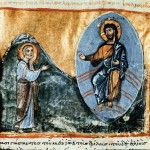
What It’s About: This is a prophetic text, and in the tradition of prophecy in the Hebrew Bible, this is a kind of geopolitical commentary. It is taking stock of things, surveying the nations and assessing the place of God’s people among them. This passage is usually dated to the exile, and so it may be that it comes from a time when Judah languished in defeat and estrangement. It’s not surprising, then, to see a hopefulness of a king coming from Bethlehem–a place associated with David, and therefore the Davidic line.
What It’s Really About: This is really about messianism. This is a text that looks forward to a time of restoration for God’s people, when things will be put back as they ought to be. But–significantly–this is also a passage that looks forward to a time of peace. This is not simply a nationalistic text, in the vein of “make America great again.” This is a vision of a new kind of world, accompanied by a messianic leader out of David’s line, but also characterized by a peacefulness reigning over the earth. (The preceding chapter features the famous lines about beating swords into plowshares and spears into pruning hooks). So there is a dual vision here, but it is an integrated dual vision (if that makes sense). The people of God will be restored, and concomitant with that will be the advent of peace on earth. These are big hopes.
What It’s Not About: This is not really relevant, exactly, but it is every first-year Hebrew student’s favorite bit of trivia. Bethlehem, which is featured in this passage and also in most of our stories about Christmas, is made up of two words in Hebrew: bet and lechem. The first means “house,” and the second means “bread.” So, Bethlehem means “house of bread.” Remember that next time you’re making your gingerbread houses.
Maybe You Should Think About: Advent is a season in which Christians are consumed by the wait for Jesus, the one Christians see as the fulfillment of the “one who is to rule in Israel” part of Micah 5. But maybe we should think about preaching the other part of this text, the other “advent” that is in view: the advent of peace. Peace is a significant part of the rhetoric of Advent, but I don’t know that we always take it seriously. To proclaim the coming Jesus is to proclaim the advent of peace, and we live in a time when proclaiming God’s peace is incredibly important. I’m not talking about inner peace, Oprah-style. I’m talking about peace peace, the stuff that keeps our children from dying in wars. Maybe we should think about preaching that this Advent.
What It’s About: This is a complicated passage. It is coming out of a preceding critique of the law, and contrasting the law with the embodiment of Jesus. It’s doing so in a way that places Christian claims over and against the Jewish practices of its day, so it requires care in interpreting and preaching in order to avoid making supercessionist claims.
What It’s Really About: Hebrews is endlessly fascinating for its creative metaphors. I’ve said before in this blog that Hebrews is a kind of window into a time when the Christian tradition was still very young, and when the theological categories and constructs that have come to define the faith didn’t exist yet. Hebrews is really trying things out, seeing what works and what doesn’t. This view of Jesus as an embodiment of God’s sanctification, as we see in 10:10, is fascinating, and it’s a really interesting text for Advent. What do we mean when we preach incarnation? What can incarnation mean for the nature of God? You can see the beginnings of the tradition wrestling with this in this text.
What It’s Not About: One thing that you absolutely have to remember about Christian texts from this period is that they were written in the full knowledge of the destruction of the temple. The Jerusalem temple was destroyed in 70 at the hands of the Romans (see this account for a good, if harrowing, synopsis of the events that led up to it). So any rhetoric about God rejecting sacrifices and offerings–the marks of the Jerusalem temple–have to be seen in that light. It’s kind of like what you hear people say when a church burns down: “the church isn’t the building.” The rhetoric you see in Hebrews 10 is definitely influenced by the knowledge that the temple is in ruins; it is making lemonade out of lemons. Not that Christians didn’t develop a supercessionist theology; they did. But we don’t have to repeat that theology, living as we do in the knowledge of history and the costs of inter-religious misunderstanding.
Maybe You Should Think About: How does this inform our thinking about incarnation? Most of what we say this time of year about incarnation, it seems to me, comes from the prologue of John. That’s where we get “the word became flesh” and all of that. But that’s not the only incarnational theology we have, and it would be useful to use this passage to think through what we mean when we claim that somehow God was in Jesus. The early church wrestled mightily with this question, and we shouldn’t act as if the matter is settled.
What It’s About: This is a confluence of several strands of the early Jesus story: the pregnant Mary, messianic expectation, and the forerunner role of John the Baptist. It’s the scene where John leaps in his mother’s womb upon meeting Jesus, who was also in his mother’s womb. It’s a potent symbolic moment that encapsulates the hopefulness of messianic expectation, and that looks ahead to the recognition that the adult John has of the meaning of Jesus.
What It’s Really About: For many people, this is really about the Magnificat, the song of Mary, which has received many settings in music through the centuries. In eastern Christianity this song is called the Ode of the Theotokos, which is a pretty good title too. (Theotokos means God-bearer, and is a title for Mary). The Magnificat is a staple of church music this time of year, and rightly so, for its tender and uplifting tenor. It has deep connections to Hannah’s song in 1 Samuel 2, so be sure to take a look at that.
What It’s Not About: Sometimes people debate whether these could possibly be the actual words of Mary. “Was someone standing there and writing down her words as they leapt from her mouth?” This kind of question completely misses the point of scripture, and I would argue this kind of question is the sour fruit of biblical literalism. Obviously, this is a poetic creation, meant to give power to the moment. Luke puts it on Mary’s lips as a way to give voice to the kind of thing someone would feel in that moment, with the benefit of foresight. The bible is not like a transcript, or an audio recording; it is a series of stories. Luke is telling a good story here. Who cares whether it’s a verbatim transcript?
Maybe You Should Think About: It would be interesting to put the embodiment language of Hebrews in conversation with the Jesus-in-the-womb that we encounter in Luke. Early Christians wrestled with the question of when Jesus became God; was it at the beginning of time, or at the conception, or the birth, or the baptism, or on the cross, or some other time? A text like this suggests that there was something special about Jesus, even before his birth. Think about how that relates to the Hebrews text, and its claims, and the claims we make in Advent about what kind of Jesus is being born.
















